Sometimes a dream spins rampant in your head. Riding MotoGP Circuits in Europe, for example. How many of you dream of checking one, two, or more of these incredible tracks off your bucket list? What if you could do that, and ride two-up with two-time World Superbike champion Troy Corser?
Related: 2020 BMW S 1000 RR MC Commute Review
In 2012, Corser joined The Race Academy where he worked extensively with Marcel Kramer, former French Superbike racer and current head of Racing School Europe (RSE), to develop a rider training program. I was fortunate to ride in Spain at Motorland Aragón last year with The Race Academy. At the end of 2018, the program was redesigned, and the following year the new Racing School Europe was launched offering courses at iconic tracks like Mugello, Brno, Slovakiaring, and, new for 2020, Jerez. Of course, I had to ride with them again, this time at the famed MotoGP Circuit de Barcelona-Catalunya!
Related: MotoGP Comes To Finland In 2020
Just 45 minutes from Barcelona, this beautiful track is surrounded by several smaller towns. I stayed in a cute inexpensive boutique hotel in Granollers, a 12-minute drive away (booking accommodations was super simple online with many available options in all price ranges). On a crisp early fall morning, I made my way into the pits and felt like I was visiting with old friends once again. Being a riding coach with the California Superbike School for the past 15 years, I find it worthwhile to ditch the coaching hat and be a student; there is always room to improve your own riding!
Related: 2020 BMW S 1000 RR First Ride Review
As an official partner of BMW Motorrad, RSE offers 2019 BMW S 1000 RR M package motorcycles with Metzeler RR K3 tires starting from just 329 euros per day plus course entry fee (roughly $368 USD). Full riding gear including boots, gloves, one-piece suit, and helmet are included, as are rain tires if needed. An optional upgrade package (250–300 euros; $279–$335 USD) is available for riders seeking more grip, which includes Metzeler Racetec slick tires, pit-box spot, bike stands, and tire warmers.
Each day includes briefings by either Corser or Kramer, five 20-minute on-track riding sessions with instructors, and then discussion and video review after each ride. We were split into groups of three students and I was paired with Ron Veldhuizen (former motorcycle instructor for the Dutch army and a trackday enthusiast) for the first two days.
The fast and flowing 2.8-mile, 13-corner circuit was made more challenging by several double-apex and downhill first-gear turns! It’s a track that has a little bit of everything, long straights, fast sweepers, elevation changes, and technical slow corners. To go really fast requires precise timing and extremely accurate lines.
Riding techniques covered in the curriculum include the “ins and outs of racing technology.” Things like body position and prepositioning, trail-braking, throttle steering, visual skills and reference points, tension and pressure on the bars, foot positioning, gear selection, and engine-braking were covered extensively. Putting more attention and focus on what gear I was in combined with engine-braking was certainly the biggest takeaway for me. That along with the lesson on trail-braking was where I was able to build confidence.
RSE offers track instruction for a variety of riding abilities. When booking they ask a few questions about the amount of trackdays ridden, lap times, and race experience, and students sign up as either Beginner, Advanced, Experienced, or Racer. We had riders from Canada, USA, Europe, Mexico, Lebanon, Australia, and Panama. Some had never ridden on a track before, and some were professional racers like AMA Pro roadracer Connor Funk, Canadian National racer Jordan Royds, and 16-year-old British talent and Red Bull Rookies Cup racer Max Cook.
“Troy is teaching me stuff here that even after 10 years of riding, I don’t even know!” Max said. How fascinating to be in Europe, riding a stunning track with like-minded people speaking different languages, all brought together by motorcycles!
During the first two days I worked mainly on learning the track, fine-tuning my reference points, being more accurate with my lines, and experimenting with different riding and foot positions.
However, the third day was where I was able to implement the most changes. After some student/coach changes (Funk, Royds, and I were put with Nico Dmyszewicz) we got to work. “You’re fast midcorner,” Nico told me, “but I close the gap on the drives out.” He pushed me to be more patient at turn entry, trail the brakes longer into the corner, and sacrifice some midcorner speed (especially in the long double-apex corners) to get faster on exit. This helped with overall corner exit drives and was key to me finally improving on my previous best time.
As Marcel stated in the throttle control briefing, “If you want to accelerate fast out of a corner, you need to think in straight lines. Because you can’t accelerate out if the bike is still leaned over. It’s not about who is on the throttle first, but who is full throttle first.”
Corser also talks a lot about gear selection and “back shifting” (or downshifting) to utilize engine-braking to help stabilize the bike. “It’s called chain force,” he explained. “When you back shift, it actually pulls on the bottom of the chain and brings the back of the bike down even harder into the road. So what you get is a planted feel. That’s why gears and where you shift them are so important.”
These are all things I know, but having video footage and different sets of eyes following and explaining things really helped. As did riding two-up (pillion) with Troy.
Last year at Aragón I reluctantly did it, and by reluctantly I mean I almost didn’t do it, and I screamed and swore the entire time! There I experienced firsthand how stable the motorcycle can feel while trail-braking after downshifting into first gear and carrying the brakes as Troy says, “Sooner, softer, and longer into the corner.”
At Catalunya, I was able to really feel what was meant by sacrificing midcorner speed in order to accelerate harder on exit. We hauled ass into the corners, downshifting early, trail-braking deep, sometimes sliding the rear so we were freaking sideways and then practically parking it midcorner until it was time to simultaneously roll on the gas and stand the bike up, rocketing us out.
The combination of downshifting sooner, trail-braking longer, and delaying my throttle roll on, plus the pillion ride, helped me knock a second and a half off my best time, from day 1, for an overall best of 2:01.0. All in all, an incredible three days of riding a wicked-fast and fun track with some seriously amazing people.
There really is nothing more incredible then flying to Europe, showing up at a world-renowned MotoGP circuit, and riding motorcycles with like-minded people. Despite the fact that I coach for a different motorcycle riding school, the team at RSE was welcoming, respectful, fun, and successful in passing on some slightly different but helpful riding instruction. One can always learn and improve, and I can’t wait to go back and experience the same kind of riding growth, on a different GP circuit. Talk about packing it all in, and adding some pepper to life. A little bit of this, a little bit of that, and, check mark, another MotoGP track off the list.
Check out racing-school-europe.com for more information.










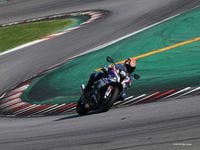
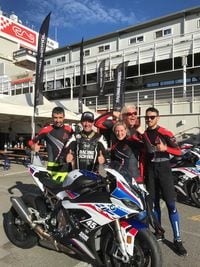

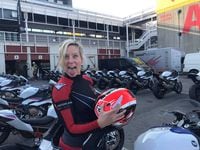
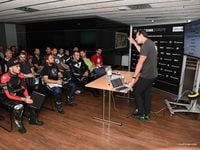
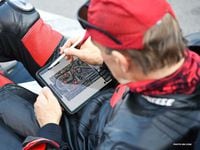






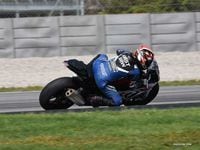
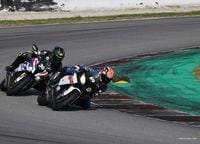


/cloudfront-us-east-1.images.arcpublishing.com/octane/FZXHNOQRNVA3BIDWAF46TSX6I4.jpg)
/cloudfront-us-east-1.images.arcpublishing.com/octane/JRSFLB2645FVNOQAZCKC5LNJY4.jpg)
/cloudfront-us-east-1.images.arcpublishing.com/octane/ITNLTIU5QZARHO733XP4EBTNVE.jpg)
/cloudfront-us-east-1.images.arcpublishing.com/octane/VZZXJQ6U3FESFPZCBVXKFSUG4A.jpg)
/cloudfront-us-east-1.images.arcpublishing.com/octane/QCZEPHQAMRHZPLHTDJBIJVWL3M.jpg)
/cloudfront-us-east-1.images.arcpublishing.com/octane/HXOUJXQWA5HBHGRO3EMJIGFMVI.jpg)

/cloudfront-us-east-1.images.arcpublishing.com/octane/3TIWWRV4JBBOLDVGRYECVVTA7Y.jpg)
/cloudfront-us-east-1.images.arcpublishing.com/octane/KIX5O23D5NAIBGFXBN3327DKZU.jpg)
/cloudfront-us-east-1.images.arcpublishing.com/octane/7GJYDUIPXRGMTMQKN6ONYOLBOU.jpg)
/cloudfront-us-east-1.images.arcpublishing.com/octane/MUQLOVLL2ZDGFH25ILABNBXKTI.jpg)
/cloudfront-us-east-1.images.arcpublishing.com/octane/TNOU5DNE2BC57MFPMGN2EIDXAM.jpg)
/cloudfront-us-east-1.images.arcpublishing.com/octane/GTCXACQGJ5HAPDTGWUQKDEH44E.jpg)
/cloudfront-us-east-1.images.arcpublishing.com/octane/S35YGSEMEZB4BLTDJTSZPF4GLA.jpg)
/cloudfront-us-east-1.images.arcpublishing.com/octane/5UOT6HPX2JFMRJAX6EH45AR4MQ.jpg)
/cloudfront-us-east-1.images.arcpublishing.com/octane/OKWOJWAKP5EP3OACCRRWPCIX2Q.jpg)
/cloudfront-us-east-1.images.arcpublishing.com/octane/2WF3SCE3NFBQXLDNJM7KMXA45E.jpg)
/cloudfront-us-east-1.images.arcpublishing.com/octane/G4MG6OUCJNBSHIS2MVVOTPX65E.jpg)
/cloudfront-us-east-1.images.arcpublishing.com/octane/IIGGWFOTOJGB7DB6DGBXCCMTDY.jpg)
/cloudfront-us-east-1.images.arcpublishing.com/octane/QSTCM6AVEZA5JJBUXNIQ3DSOF4.jpg)
/cloudfront-us-east-1.images.arcpublishing.com/octane/U4I7G625B5DMLF2DVIJDFZVV6M.jpg)
/cloudfront-us-east-1.images.arcpublishing.com/octane/B6XD6LS6IVCQPIU6HXDJSM3FHY.jpg)
/cloudfront-us-east-1.images.arcpublishing.com/octane/ICL63FEDDRDTTMINYICCEYGMDA.jpg)
/cloudfront-us-east-1.images.arcpublishing.com/octane/FCGZHQXRBZFLBAPC5SDIQLVF4I.jpg)